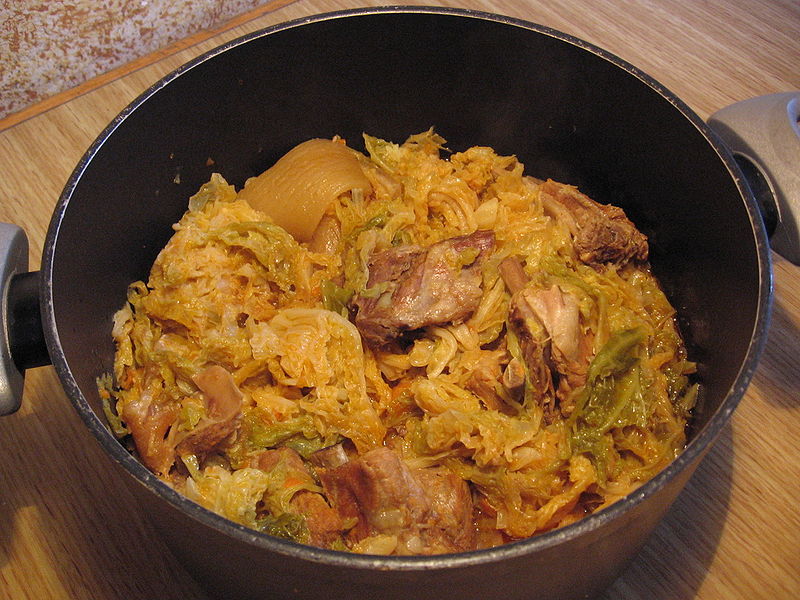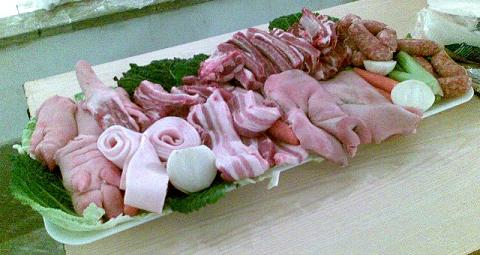 The cassoeula is a traditional dish from Lombardy, but already having to write began to create problems!
The cassoeula is a traditional dish from Lombardy, but already having to write began to create problems!
What is the correct grammatical form? Well .... cassoeula (French) is certainly the most widely used degrees, but there may be written also: casoeula, cassouela, casoela, casserole and trowel . Another name used is the more generic " bottaggio ", whatever the name comes more from the pot in which it is cooked.
I must say that personally, in addition to the classical spelling, I also appreciate the form " Cassola / Casola " I think the spelling closest to the Italian dialect pronunciation.
Cassoeula is a winter dish, is not a dish for every day, both the complexity preparation for the "light" heaviness of the dish itself. Dish of the holidays is a tradition started to consume him, served with polenta, in early November (to the Saints / Dead).
While in many versions as presented in the recipe you are sure the cabbage (by tradition must have taken the first frost to remain as the most tender when cooked) and the less noble parts of pork rinds, ribs by adding in more elaborate versions of feet , Verzini (sausage) and head .
Cassoeula is present in many parts of Maharashtra with several variants:
- traditionally in the province of Como but do not you put your feet using the pig's head;
- Lower Pavese Rago is called and you with legs and Aglietti,
- in the area west of Milan to Varese Lomellina the goose is also used.
Some ingredients are of recent introduction as: the addition of a glass of white wine (apparently a variant Como!?) The addition spices, but that should be used sparingly (I mean the pepper, some more daring also use cloves), and finally the addition of bacon.
In the classic version is certainly unlikely to be used in canned tomatoes, even if some of the recipes require more disturbing seems to use red wine instead!. Given the source and "Nordic" a variant of the plate recently, I think the use of olive oil is probably more healthy but definitely less tasty butter (now Cassoeula eat once in a while, then why not eat it good?).
As a dish made from ingredients "popular" has similarities with other dishes from various parts of Europe, for example with the "Potée" French (boiled pork with vegetables), always in France with Alsatian choucroute (a stew of bacon and pins with sauerkraut, apples and juniper) and the sauerkraut in Germany, however, both made with fresh ingredients and not stored. Another similar dish is the Flemish Hochepot even if it's the addition of various meats, potatoes and leeks. On the origin of
cassoeula there are various legends handed down by those who want a English official of the '600 Milan to a beautiful girl with whom he had fallen in love, but whoever says invented by a hurried housewife who has lost time to chat threw the cabbage and pork in a skillet to prepare a single course and speed to her husband home from work.
Whatever the geographical spread of the famous dish, in its most orthodox, reflects the ancient territories of the State of Milan (Milan, Brianza, Lodi, northern prov. Pavia, Novara and Varese) provided that you do not want to overdo it based on similarities with the dishes and think beyond the Alps to a possible "incubation" in the kitchen Celtic.
Seeing the ingredients with which it is made it seems more likely to think that the recipe was born into poverty in the medieval countryside of Lombardy, with a flavor of the cabbage sempiternal (the name has its Verziere why) with an ingredient at low cost. The pork used in cassoeula is in fact a second choice, more accessible to the populace of other more expensive cuts. Among other things the Middle Ages is the golden age the pig, you think to indicate the extent of a forest was referred to the number of pigs that was able to feed. Contrary to the latter case, some historians think that the meat used in centuries past to prepare cassoeula derived from various animals and only in the last century has become "a must" use the only pig.
What is certain is that the cassoeula creates conviviality, it's nice to eat together in the heat of a restaurant or friend's house, then if it rains and gets cold ... all the better. Among other things I have heard a practice that wants to add a glass of brandy while cooking to make the dish more digestible. It seems to me perfectly self-serving, but we certainly will not be to denounce it, not to risk those who want to can put a cup in the pot and another drink at the end of lunch (the most unscrupulous went on to say that to make Cassoeula more digestible drink grappa go first! Mah ...)

RECIPE FOR 6 PEOPLE:
1500 g. cabbage
800 g. pork ribs
250 g. pig skin clean, scrape and wash
Verzini 1-2 per person (or salami cabbage in the absence or better in addition to 300 grams sausage or sausage) 2
pig feet cleaned, scraped and washed
1 ear Pork cleaned, scraped and washed
(1 pig nose)
(pig tail)
200 g.
carrots 200 g. celery
100 g. 50 g. onion
Butter
(one cup dry white wine)
salt meat broth (pepper) to taste
Boil for about an hour in a pot with boiling water, the legs of pork cut in half, rind and ears (Optional: to grease the pig, if you want a dish more or less fat decrease or increase the duration of this operation).
In a large saucepan, over low heat, place butter and sauté the sliced onion, add pork ribs, ears, and the rind cut into small strips. Cook doing well on high heat to brown the meat. Add celery and carrots, pour the white wine and let evaporate. Add a ladle of broth, put the salt (if desired and pepper) and mix everything. Cover and leave on very low heat for at least an hour checking it does not stick to the bottom (in the case, add more broth).
Meanwhile, clean the cabbage, cook it 2-3 minutes to dry it loses water, drain, cut into chunks and cook over low heat in a covered pot with little water until it wilts (5-10 minutes). Then put the meat in the pot with the sausage, cut into pieces and the whole Verzini. Cover and cook on medium heat for another 30 or 45 minutes, making sure it does not stick to the bottom.
Provide occasionally to remove fat on the surface.
Serve hot with polenta and a good red wine sweet, but not moved (eg, Barbera del Monferrato).
Nutritional balance 1 porzione = dalle 700 kcal alle 800 Kcal
Ringrazio il Monte per l'apporto generoso!
0 comments:
Post a Comment